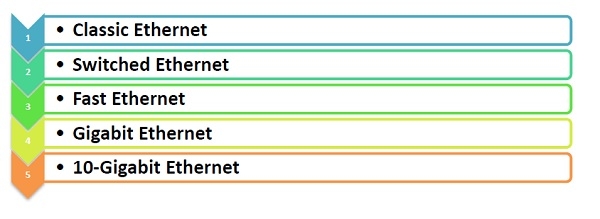
 Data Structure
Data Structure Networking
Networking RDBMS
RDBMS Operating System
Operating System Java
Java MS Excel
MS Excel iOS
iOS HTML
HTML CSS
CSS Android
Android Python
Python C Programming
C Programming C++
C++ C#
C# MongoDB
MongoDB MySQL
MySQL Javascript
Javascript PHP
PHP
- Selected Reading
- UPSC IAS Exams Notes
- Developer's Best Practices
- Questions and Answers
- Effective Resume Writing
- HR Interview Questions
- Computer Glossary
- Who is Who
Retrospective on Ethernet
Ethernet is a set of technologies and protocols that are used primarily in LANs. It was first standardized in the 1980s as IEEE 802.3 standard. It has been around since its inception and has seen different phases of development. A few other technologies have seen such consistency in usability.
Advantages of Ethernet
Ethernet is simple and reliable.
It is economical since it mostly uses inexpensive twisted-pair cables.
It is easily maintainable. It does not require installing any software, except for installing the network drivers.
It is very less prone to failures. Once the network components are in place and correctly connected, it works perfectly.
It can be easily scaled to the upgraded versions of Ethernet.
It is compatible with the TCP/IP protocol, which is the most dominant networking protocol.
Ethernet has evolved in leaps and bounds. Speeds have increased manifolds.
Versions and Evolutions
The first standardized version of Ethernet was the classic Ethernet. Since then, a number of the transformation of Ethernet technology has taken place.
The most pronounced Ethernet technologies are −

Classic Ethernet − Classic Ethernet is the original form of Ethernet first standardized in the 1980s as IEEE 802.3 standard. It provides data rates between 3 and 10 Mbps. The versions are 10BASE-5, 10BASE-2, 10BASE-T and 10BASE-F.
Switched Ethernet − In switched Ethernet, the hub connecting the stations of the classic Ethernet is replaced by a switch. The switch connects the high-speed backplane bus to all the stations in the LAN. The other specifications are the same as classic Ethernet.
Fast Ethernet − Fast Ethernet carries data traffic at 100 Mbps (Megabits per second) in local area networks (LAN). It was launched as the IEEE 802.3u standard in 1995 and stayed the fastest network until the introduction of Gigabit Ethernet. The versions are 100BASE-X, 100BASE-TX, 100BASE-FX and 100BASE-T4.
Gigabit Ethernet − Gigabit Ethernet (GbE) achieves theoretical data rates of 1 gigabit per second (1 Gbps). It was introduced in 1999 and was defined by the IEEE 802.3ab standard. The versions are 1000BASE-X, 1000BASE-CX, 1000BASE-SX, 1000BASE-LX and 1000BASE-T.
10-Gigabit Ethernet − 10-Gigabit Ethernet achieves maximum rates up to 10 gigabits per second (10 Gbps). It is also known as 10GE, 10GbE or 10 GigE. It is defined by the IEEE 802.3ae standard and introduced in 2002. The versions are 10GBASE-SR, 10GBASE-LR, 10GBASE-ER, 10GBASE-CX4 and 10GBASE-T.

